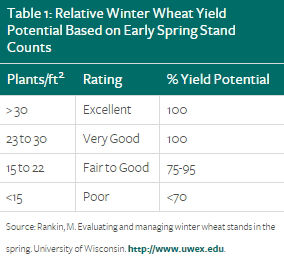3 MIN READ
Assessing Freeze Injury to Winter Wheat
March 18, 2018
Key Points
- As weather warms and wheat begins to grow, now is the time to assess stands for winterkill.
- Stand evaluations will help you make decisions on whether to keep the stand, destroy it to go to another crop, or implement appropriate management strategies.
Making informed decisions about your winter wheat stand in the spring can translate into more yield potential in the summer. When wheat fields begin to turn green is the perfect time to assess stand condition and any freeze injury. Winter dormancy breaks at soil temperatures of 39°F or higher so evaluation of the wheat crop can begin after about 10 to 14 days of warm weather.
Wheat Stand Evaluation
Management
Optimum plant stands for maximizing yield potential is in the range of 23 to 30+ plants/ft2(Table 1). Plant stands of roughly 15 to 22 plants/ft2 can return yields close to full yield potential when conditions are ideal. If the number of plants per square foot is determined to be 15 or above, tillering can help compensate for poor stands. If plant stand counts are below 5 to 10 plants/ft2, destroying the wheat stand and planting another crop may be justifiable.
Whole fields do not have to be abandoned if one area has a poor stand. Before you tear up a poor stand of wheat, be sure to calculate the input costs you have in the existing wheat crop, the costs of establishing another crop, and the current crop prices. The insurance company should also be contacted prior to destroying a wheat crop in order to determine options.
Sources
Fanning, B. 2012. Evaluating winter wheat stands. iGrow. South Dakota State University. http://igrow.org.
Ransom, J. 2009. Evaluating winter wheat stands. Northwest Research & Outreach Center. University of Minnesota. http://www.nwroc.umn.edu.
Rankin, M. Evaluating and managing winter wheat stands in the spring. University of Wisconsin. http://www.uwex.edu.
Web sources verified 04/28/15. 140326013801
